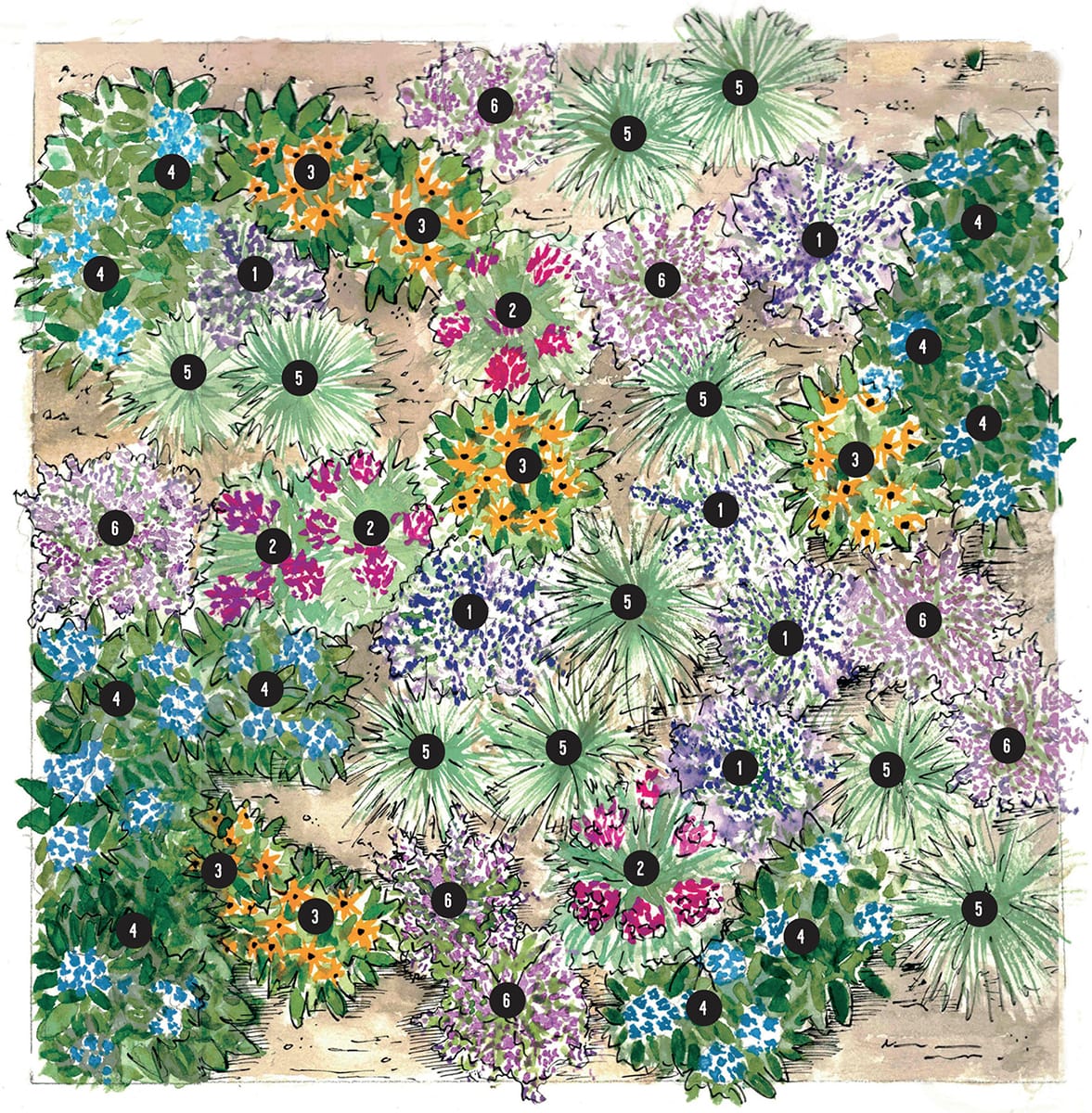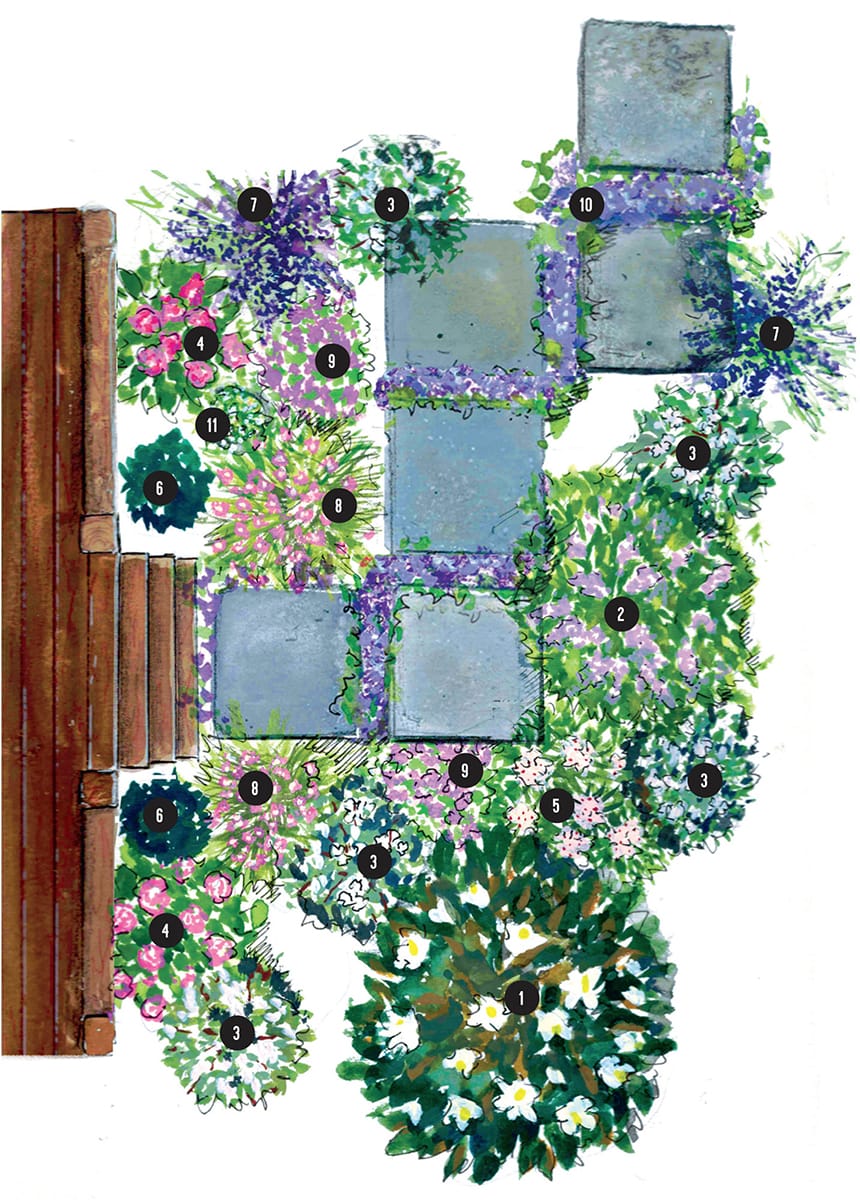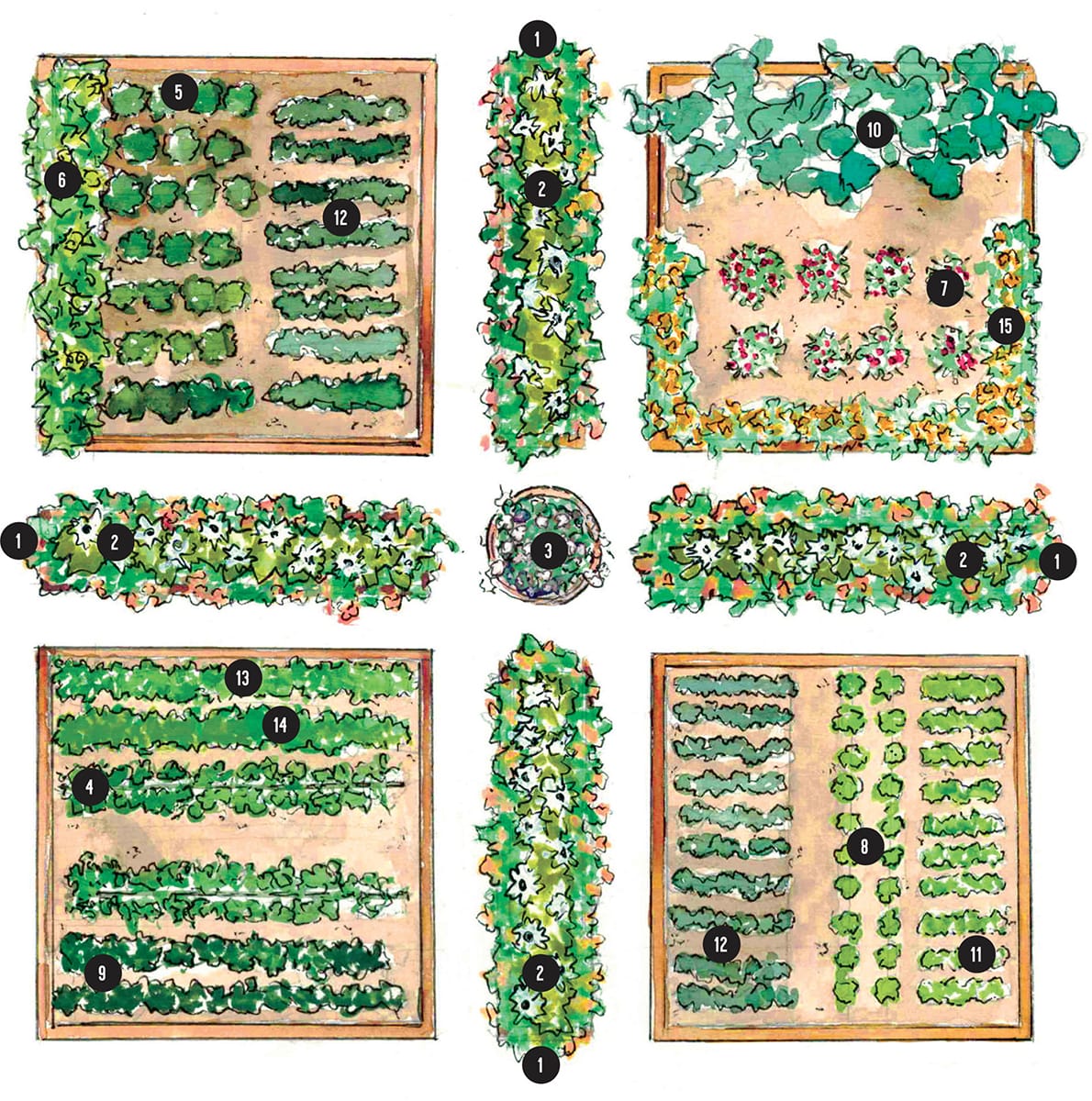3
DESIGNING WITH COMPACT PLANTS
Using compact plants in the landscape presents homeowners with endless possibilities. While wide, sweeping gardens are lovely, so too are petite gardens, especially when they’re filled with color, texture, and year-round interest. All the wonderful features of an enormous garden can be readily found in well-designed small-space gardens, too.
In truth, designing a small-scale garden is not all that different from creating a garden in a larger space, especially when it comes to remembering the basics, such as sun exposure, use, color, accessibility, and form. But, there are a few noticeable differences between the two.

DESIGNING A SMALL SPACE VS. A LARGE AREA
First, when designing a smaller garden, proper plant placement is a must. Utilize plants in a way that makes the space feel larger, not restrict the eye and block views. Compact plants are terrific for this task because they maintain their shape and size without becoming quickly overgrown. Adding a few vertical pops of upright growth among lower-growing plants lends a perception of depth to the garden and opens it up. The narrow, conical trees and evergreens found in chapters 4 and 5 are perfect for this job.
Also, using layers of plants is even more critical in small spaces than larger ones, as it enables the gardener to fit more plants into the area and to give a sense of depth even to the smallest of spaces. From trees that reach for the sky to groundcovers that hug the soil and every plant layer in between, make use of the vertical space available by designing a garden with multiple layers in play. Compact plants are so perfect for small gardens because they can be planted closer together. Creating these layers is, in some ways, simpler than it is in larger spaces where we’re often tempted to plant things a little too close together.
And last, designing for accessibility is certainly easier in smaller spaces. Though compact plants in general require less maintenance than full-sized plants, you’ll still have to get into the garden to weed, water, and prune from time to time. A well-designed small-scale garden plans for accessibility by including walkways and paths throughout.
DESIGN FOR LOW MAINTENANCE AND PLANT HEALTH
In addition to creating a lovely space, you also want a garden full of healthy plants. What’s the use in having a well-designed garden if it’s full of disease-ridden foliage that requires constant upkeep?
HERE ARE SOME TIPS FOR DESIGNING FOR LOW MAINTENANCE AND PLANT HEALTH:
• Limit fungal diseases by properly spacing plants. Yes, most compact varieties can be planted together fairly tightly, but do pay attention to the mature size of the plant and be sure you give it plenty of room to reach its full potential. Overcrowded plants are a welcome mat to fungal diseases.
• Restrict weed growth by designing weeds out of the garden from the start. Planting in layers readily accomplishes this. By including plenty of low-growing plants and groundcovers in a ground-level matrix, the soil is shaded. If done well, this serves as a sort of living mulch and prevents weeds from taking hold.
• Include a diversity of plants in your small-scale garden to prevent major pest issues. Several studies have shown that the greater the diversity of plant materials a garden has, the fewer pest outbreaks it faces. But, not to worry; including many different species of plants in your garden doesn’t mean it has to be a jumbled mash-up of plants. By judiciously planning the placement of each plant prior to planting, a thoughtful, cohesive, and beautiful garden is the result.
DESIGN FOR COMFORT, MYSTERY, AND VISUAL EXPANSION
A sense of the unknown makes a garden appear to be larger than it is. When a visitor comes to your garden, they should wonder what’s around the corner or where a path will take them, even if your garden is pint sized. Whether it’s a meandering path, a peek-a-boo hole cut into a gate, a window made of mirrors placed on a shed wall, or a tiny playhouse tucked into the corner of the yard, there are many ways to add a sense of mystery to a small garden.
Open views, if you have them, should be accentuated. Create a “garden room” in these areas to give visitors pause and encourage them to stop and enjoy the view, even though they’re in a confined space.
And last, include plenty of “living space” in your garden. A bistro table and chairs, a well-placed bench, or a patio sofa add comfort and personality to your small garden. Don’t be afraid to include a pop of color or funk with these features; it’s a great way to stylize the space.

When designing a garden of compact plants, be sure to include plenty of places for rest and relaxation.
Despite all of these tips and endless internet and Pinterest ideas at your fingertips, many gardeners still find themselves overwhelmed at the thought of designing a garden space, no matter how small. Turning to a professional designer is always a good idea, especially if design isn’t your cup of tea. And so, to make the job easier, I’ve brought in some experts for the rest of this chapter—experts who make their living designing gardens of every shape and size.
I invited ten garden design professionals from all around North America to create a small-scale garden design with an accompanying plant list. Whether you use these plans as inspiration to come up with your own design or use their exact design right down to the last dwarf hydrangea, I hope they help you create the small-scale garden of your dreams.
SMALL-SCALE GARDEN DESIGNS FROM THE EXPERTS
Compact perennial garden
This modular perennial garden design was created for an 18' × 18' space, though it’s easily repeated as a “stamp” for use in larger spaces. Feel free to cut it in half or even quarters if your space is more restricted. The plants found in this garden will survive down to –20°F.
The compact perennials chosen for this design are all known for their resilient nature, colorful blooms, and minimal maintenance requirements. It’s designed for use in any full-sun area. From a mailbox garden to a patio planting, this compact perennial garden offers many beautiful possibilities.
Austin Eischeid is a garden designer based in Chicago, Illinois. He specializes in dynamic, naturalistic, seasonally sensitive, and low-maintenance landscapes. He is currently working on designs to renovate the landscape at Chicago’s Millennium Park. See more of his work at www.AustinEischeid.com.

Pocket-sized pollinator garden
Even gardeners with limited space play an important role in supporting pollinators. This delightful design combines bee- and butterfly-friendly flowering perennials and ornamental grasses, backed by a small flowering tree, to bring insect life to the landscape. Requiring just a 12' × 12' quarter-circle of land, this colorful garden is packed with blooms and perfect for a front- or backyard planting.
All of the plants found in this design are winter hardy down to –10°F, with many of them being winter hardy down to –20°F. The anchor of this garden is a chaste tree (Vitex agnus-castus) that reaches just 8 to 10 feet in height, has a shrubby growth habit, and produces spires of blooms.
Helen Weis is the owner of Unique by Design Landscaping & Containers, a boutique design firm in Edmond, Oklahoma. She is one of the top container designers in the industry and among Oklahoma’s favorite perennial garden designers. Helen is well known in the landscape industry for her contributions to many national publications, including Fine Gardening magazine, the Association of Professional Landscape Designers’ quarterly magazine The Designer, and State-by-State Gardening’s Oklahoma Gardener, in addition to several books. Find Helen at www.ubdlandscape.com.

Patio garden with compact trees, shrubs, and perennials
Small backyards often come with even smaller outdoor living spaces. This design maximizes the potential of an area that’s just 12' × 20' by surrounding a stone, brick, or concrete dining patio with flowering shrubs and perennials. The corner of the space is graced with a single, open-formed tree that won’t take over the space or make visitors feel closed in.
All of the plants used in this plan are winter hardy down to –20°F, and none of the shrubs grow taller than 5 feet in height, with most staying shorter. The texture and bloom power of the shrubs in this design turn your patio into a backyard oasis.
Naomi Brooks is a designer from the Hudson Valley of New York, where she helps to dream, design, and deliver uncommon outdoor spaces. She takes a crazy amount of photographs for her lectures to illustrate how the geometry of architecture and the patterns in our natural landscapes can be incorporated into garden designs. Find Naomi and her company, Verdant Landscapes, online at www.verdantlandscapes.com.

Tex-Mex courtyard garden for dry climates
This stunning Tex-Mex courtyard garden is perfect for dry climates. The plants found in it require little irrigation, and the garden is filled with plants that shine in arid regions. Surrounded on three sides by a wall, the 36' × 21' design has a fountain and a seating area. Star jasmine climbs the walls, while a slow-growing sago palm anchors each corner.
Each of the planting beds in this design is surrounded with a low, 18-inch-tall stucco wall to hold the soil and mulch in place, but other materials could be used as well. Though most of the plants in this garden will not survive the winters where temperatures dip below freezing, it’s ideal for areas with warm, dry winters.
Jenny Peterson is an Austin, Texas–based landscape designer, author, and speaker focusing on wellness and healing gardens. She is the author of The Cancer Survivor’s Garden Companion: Cultivating Hope, Healing and Joy in the Ground Beneath Your Feet, which received the Silver Award from the Association for Garden Communicators. Find Jenny at www.JennyNybroPeterson.com, where she writes about healthy gardens, healthy lives, and urban farming.

Small-scale front entrance garden
Dressing up your home’s front entrance is one of the easiest ways to add value and interest to your property. The small-statured plants included in this lovely entrance garden are not just the perfect fit; they’re also wonderfully fragrant.
Flanking a casual walkway constructed of steppingstones or blocks, every shrub and perennial included in this garden welcomes guests and residents, alike, with a divine scent and colorful blooms. The area measures just 16' × 20', and all of the plants found in it are winter hardy down to at least 0°F.
Sue Goetz is a garden designer, writer, and speaker from Tacoma, Washington. Through her business, Creative Gardener, she works with clients to personalize outdoor spaces. Her design work has earned gold medals, the Sunset Magazine Award, and the Fine Gardening award at the Northwest Flower & Garden Show. Sue is also a passionate herb gardener and the author of The Herb Lover’s Spa Book and A Taste for Herbs. Find Sue online at www.thecreativegardener.com.

Shady nook of compact plants
Shady garden areas are among the most challenging for gardeners. While brightly hued blooms often play second fiddle in a shade garden, the real standouts are perennials, shrubs, and trees with colorful foliage and interesting textures or forms.
For this near-symmetrical shade garden, the designer combined multiple leaf textures together to create a cool, calming space meant to flank a walkway or garden path. Plant this 21' × 23' shady nook at the front or rear of a home or next to a patio or deck. All the plants found in this garden require fewer than 4 hours of sun per day and are winter hardy down to –20°F.
Jan Coppola Bills is the author of Late Bloomer, a certified landscape designer, advanced Master Gardener, entrepreneur, and contributing writer for State-by-State Gardening magazines. After a successful career in the corporate world, she made a major life reassessment and followed her heart: She traded in her heels for Wellies and started the Detroit-area landscape design company, Two Women and a Hoe® (www.twowomenandahoe.com).

Backdoor cocktail garden
Cocktail gardens are a place to sit, relax, and unwind—especially during the evening hours—but they can also include plants used to make or embellish a beverage. This unique backdoor cocktail garden includes a nook near the house to sit and sip as well as a circular stone overlook with a seatwall for socializing with friends and family.
This large design is filled with woodland plants that include many North American natives and edible plants such as pawpaw, elderberry, gooseberry, clove currant, and pink currant. The space measures 56' × 48', but it can easily be scaled down for smaller backyards. All of the plants found in this design are winter hardy down to at least –20°F.
Jennifer R. Bartley traveled extensively throughout France to study traditional potagers (kitchen gardens) and has created her own versions for American chefs and gardeners. Emphasizing functionality and design in her work, Jennifer seeks to create beautiful, vibrant gardens that embrace a simpler life. A landscape architect in Granville, Ohio, Jennifer is also the author of Designing the New Kitchen Garden and The Kitchen Gardener’s Handbook. Find her online at www.americanpotager.com.

Mini herb garden of compact varieties
This beautiful little all-in-one herb garden includes culinary herbs, tea herbs, and edible flowers. The space is only 6' × 6', so it’s a great way for a beginner gardener or anyone with limited space to grow a selection of herbs. Designed to be grown in a raised bed made from wooden boards, the central diamond is also made from a wooden frame. Raise it to a second level or keep it on-level with the outer bed frame.
While there are some perennial herbs in this garden (including thyme, oregano, lavender, and chives), the remaining herbs will not survive the winter where temperatures dip below freezing. For this reason, the frost-sensitive herbs, such as basil, dill, lemongrass, parsley, and nasturtiums, need to be replaced each spring.
Niki Jabbour is a garden writer from Halifax, Nova Scotia, whose books include The Year-Round Vegetable Gardener and Veggie Garden Remix. She is also the host of The Weekend Gardener radio show and writes regularly for magazines and newspapers like Fine Gardening, Horticulture, and Birds & Blooms. Find Niki online at www.savvygardening.com.

Balcony container foliage garden
For those with extremely limited growing space, containers are a wonderful option for growing compact plants. This simple yet lovely container design comes from an expert who specializes in creating unique container displays that utilize interesting and varied textures and foliage colors. Use it to dress up a small city balcony, a front or back porch, or an apartment courtyard.
The combination of prized foliage plants included in this design is perfect for any garden pot with a rim diameter of at least 12 inches across. Whether made from glazed ceramic, fiberglass, plastic, or another material, as long as the container is at least 18 inches deep and is regularly watered throughout the growing season, the plants will thrive. Though several of the varieties found in this design will not survive the winter where temperatures drop below freezing, the container is easy to replant at the start of each growing season.
Christina Salwitz is a personal garden coach, container garden designer, and public speaker in Renton, Washington. As coauthor of Fine Foliage and Gardening with Foliage First, Christina provides every level of gardener with a fresh and objective perspective on their special needs. She’s appeared in and written for magazines such as Better Homes & Gardens, Fine Gardening, and Horticulture. Learn more about Christina on her website, www.personalgardencoach.wordpress.com.

Kitchen garden with compact edible plants
Kitchen gardens are naturally designed to be smaller than a typical vegetable garden. They’re the perfect place to grow herbs, greens, vegetables, and edible flowers. This garden is meant to be located just outside the kitchen door, so the cook can easily dash outside to clip a few leaves for a salad or vegetables for the pot.
Measuring just 18' × 18', the garden is constructed of four square beds and four rectangular ones. The bed areas can be at ground level or they can be raised beds constructed of wood, brick, or blocks. Filled with compact vegetable varieties and flowers that fit perfectly into the small beds and still produce ample food, this garden is centered with a large pot filled with dwarf sweet peas. With the exception of the tomatoes, which should be planted into the garden as 4- to 6-week-old transplants, the vegetables and flowers found in this garden are easily grown from seed planted directly into the garden in most growing zones.
Ellen Ecker Ogden is a kitchen garden designer and author of The Complete Kitchen Garden and The New Heirloom Garden. As a student of classic garden design, she gains much of her inspiration from European potagers and lectures widely on her love of growing beautiful food. You can find Ellen online at www.ellenogden.com.
Though these design plans include many wonderful compact plant varieties, there are so many more available to gardeners. As you’re about to see, compact plants are perfect not just for beautifying outdoor spaces and providing edible fruits and vegetables for the family; they’re also good at overcoming various challenges in the landscape. Next, let’s take a look at a few ways that compact plants can make even your worst gardening woes disappear.
